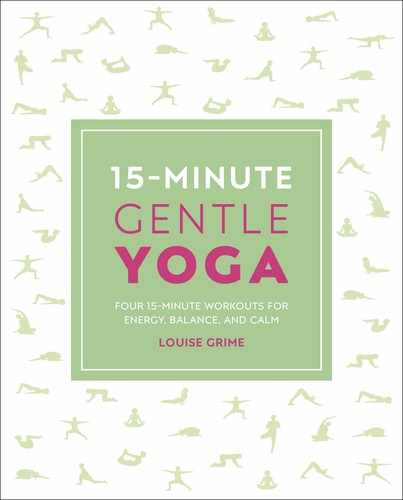
meditation
Meditating helps you achieve inner and outer harmony and feel alive and at
peace. Once you get into the habit of meditating, it becomes a part of you.
Watching your breath (pranayama) helps you keep focused and become
aware if you are pushing yourself too far in your practice.
Use meditation to clean your mind. We clean our
bodies, teeth, clothes, and home, but often ignore
our inner self as if it does not exist. It takes discipline
and is not easy, but like everything, you have to
practice to reap the benefits.
HOW TO MEDITATE
Set aside a certain amount of time each day to
meditate. It helps if it is the same time each day;
early morning or early evening are good times, but
choose a time that fits in with your lifestyle. Try to
meditate in the same place each day. Find a quiet
corner in your home, where you can create a
peaceful atmosphere. Light a candle or place
a bowl of flowers or a picture of someone who
inspires you there.
You can meditate sitting in a chair or on the
floor—whatever feels best. If you choose to sit on
a chair, use a comfortable, upright chair and sit on
it with your back straight, not leaning on the back.
Place your feet firmly on the floor with your hands
resting on your thighs. You can either kneel or sit
cross-legged on the floor. Choose one position
to sit in for the whole period. Sit up straight on
a cushion or two.
Set a timer and sit still, watching your breath,
repeating a word, or holding a vision in your mind.
Be kind to yourself because it is not as easy as it
sounds. Do not be too ambitious to begin with. Set
a manageable amount of time aside for you to sit
there, with all your thoughts and discomforts, and
keep returning to that simple breath, mantra, or inner
vision. Sit still, even if you feel discomfort,
pain, itchiness, and restlessness, coming back to
your focus point every time you notice you have
wandered off. When the timer goes off, even if you
want to stay longer, finish there, and repeat the
same every day, slowly building up to about 30
minutes of meditation once or twice a day. After
regularly meditating for about a month, you may
notice that you are calmer and that you feel more
spaciousness in your life.
PRANAYAMA
Your best friend in yoga is your breath. You
should be watching your breath in the background
constantly as you practice. People who are new
to yoga are very often shallow breathers. Becoming
aware of this is a significant first step. It is important
to let the breath flow freely while performing the
postures. As a beginner, you are not trying to control
the breath, but just getting to know it as it is. If the
breath becomes labored and shaky, this means you
are going too far. Watching your breath is a great
monitor and focus point to prevent your mind from
wandering onto everyday matters while you are
practicing. Your breath can lead your mind to parts
of the body that are asking for special attention and,
over time, you can learn to release tensions and
blockages with the help of your breath.
Meditate in comfortable, relaxing surroundings. Sit
cross-legged, on a chair, or kneel, placing your hands
on your lap or resting on your thighs.
US_106-107_Meditation.indd 106 21/06/2019 11:13

US_106-107_Meditation.indd 107 21/06/2019 11:13
..................Content has been hidden....................
You can't read the all page of ebook, please click here login for view all page.
